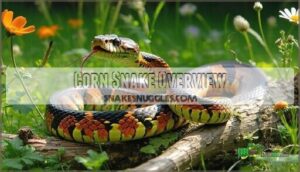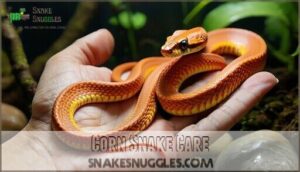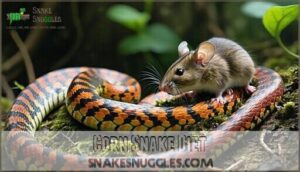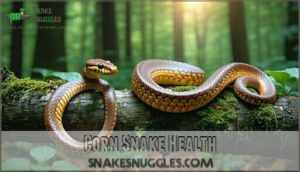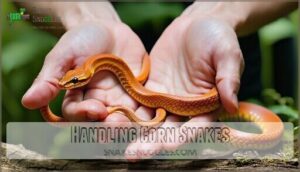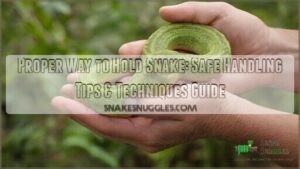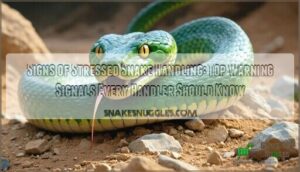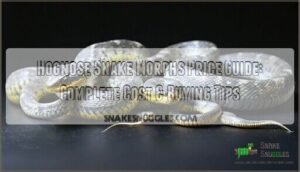This site is supported by our readers. We may earn a commission, at no cost to you, if you purchase through links.
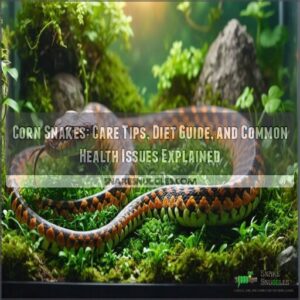 Corn snakes are non-venomous reptiles native to the southeastern United States.
Corn snakes are non-venomous reptiles native to the southeastern United States.
You’ll find they grow 3-5 feet long and live 15-20 years with proper care.
These docile snakes come in various colors called "morphs," from classic orange-red to albino varieties.
They need a secure enclosure with proper temperature gradients (75-85°F), hiding spots, and clean water.
Corn snakes eat primarily mice, requiring feeding every 5-7 days for juveniles and 7-14 days for adults.
Their easy-going nature and minimal maintenance make them ideal first-time reptile pets.
Understanding their specific habitat needs prevents common health issues that many owners overlook, and with proper care, they can live a long and healthy life, making them a great choice for those who want a pet with a minimal maintenance requirement.
Table Of Contents
- Key Takeaways
- Corn Snake Overview
- Corn Snake Care
- Corn Snake Diet
- Corn Snake Health
- Handling Corn Snakes
- Frequently Asked Questions (FAQs)
- How venomous is a corn snake?
- What is the biggest trouble with corn snakes?
- Is a corn snake poisonous?
- Is a corn snake a good pet?
- Do corn snakes like to be held?
- Are corn snakes aggressive?
- How long do corn snakes typically live?
- What are corn snakes native habitats?
- How often should a corn snake shed?
- How can I identify a healthy corn snake?
- Conclusion
Key Takeaways
- You’ll find corn snakes are non-venomous, docile reptiles that grow 3-5 feet long and live 15-20 years with proper care, making them ideal first-time reptile pets.
- You need to maintain a secure enclosure with temperature gradients (75-85°F), proper humidity (40-60%), and appropriate substrate like aspen shavings to prevent health issues.
- You should feed your corn snake appropriately sized rodents every 5-7 days for juveniles and 7-14 days for adults, adjusting prey size as your snake grows to avoid digestive problems.
- You can build trust with your corn snake through gentle, consistent handling sessions, being mindful of stress signs and avoiding handling during shedding periods or right after feeding.
Corn Snake Overview
Corn snakes are non-venomous, medium-sized reptiles known for their striking patterns and calm temperament.
Native to the southeastern United States, they thrive in grasslands, forests, and farmlands, adapting well to captivity.
Species Characteristics
Corn snakes, scientifically called Pantherophis guttatus, are a stunning snake species known for their color variations and calm temperament.
These snakes usually grow 3 to 5 feet long, with males often smaller than females.
Their lifespan can reach an impressive 15-20 years with good care.
Their even-tempered behavior makes them perfect for beginners, and their diverse morphs add a unique appeal, creating endless opportunities to explore their fascinating patterns and colors.
Native Habitat
Learning about a corn snake’s habitat helps you understand their needs.
These reptiles thrive in the **southeastern U.S.
**, blending into diverse ecosystems.
They prefer warm, humid climates with:
- Woodlands and Rocky Areas: Spaces with hiding spots like logs or rocks.
- Human Proximity: Abandoned barns and fields suit them well.
- Burrows and Sandy Soil: Perfect for shelter and protection.
- Ecosystem Interactions: Active predators that help control rodent populations.
Introduced populations now thrive in the Bahamas and Virgin Islands, adapting quickly.
Color Patterns
A world of vibrant artistry exists in corn snakes, making them prized reptile pets.
Their natural hues often showcase reddish-orange blotches on lighter backgrounds, with bellies that resemble a checkerboard—hinting at their name’s origin.
Thanks to selective breeding, a kaleidoscope of corn snake morphs has emerged, offering stunning color intensity and unique pattern aberrations. Popular morph genetics include albinos, amels, and snows, each displaying remarkable variety.
Over time, some snakes may experience pattern fading, adding intrigue to their development.
The Okeetee locality features vibrant red markings bordered by black. These colorful snakes truly enhance any terrarium, creating living masterpieces.
Physical Characteristics
Corn snakes are colorful snakes known for their fascinating scale patterns and size variation.
Adults usually reach 3-5 feet long, weighing about 1-2 pounds. Their genetics create unique snake morphs, blending shades of reddish-orange with trademark checkered bellies resembling corn kernels.
With streamlined bodies and agile skeletal structures, they easily navigate tight spaces. Their sensory organs sharpen hunting skills, but proper snake care, including housing, prevents issues like scale rot.
Perfect for pet snakes!
Corn Snake Care
Caring for a corn snake means creating a safe environment that mimics its natural habitat.
You’ll need to manage its housing, temperature, humidity, and substrate to guarantee it stays healthy and stress-free.
Housing Requirements
Creating the perfect snake enclosure is key to keeping your corn snake happy and healthy.
Here’s a short, engaging blockquote in the same tone as the paragraph about snake enclosures:
A thoughtfully designed habitat transforms your corn snake from captive to thriving companion.
Start with a proper tank size: juveniles thrive in 20-gallon tanks, while adults need 30-50 gallons.
Prioritize ventilation needs with secure lids to prevent escapes.
Include hiding places for comfort and climbing branches for exercise.
Maintain a substrate depth of 2-3 inches using organic soil or sand mixes.
Regular cleaning frequency, at least weekly, keeps the habitat fresh and your pet snake safe.
For ideal setups, consider various tank options available.
Temperature Control
Temperature control is key to a healthy corn snake habitat.
Set up a temperature gradient: 85-88°F at the basking spot with a basking lamp, 78-82°F in the ambient zone, and 75°F on the cool side for natural cooling.
At night, let temperatures drop to around 75°F.
Use reliable heat sources like reptile pads or lamps, but always add a thermostat to prevent overheating.
Balancing these zones guarantees snake health, supports digestion, and mimics their natural environment.
Monitor with thermometers for stable conditions.
Humidity Levels
Humidity plays a key role in your corn snake’s habitat, especially for shedding issues and respiratory health. Keeping conditions balanced guarantees your snake stays comfortable and disease-free.
Aim for levels between 40-60%, using a hygrometer for accurate measurement.
Here are four tips for maintaining proper humidity:
- Place the hygrometer on the cool side of the enclosure for precise monitoring.
- Use enclosure misting sparingly when levels fall below 40%.
- Introduce a humidity hide, like a box with damp sphagnum moss, to support shedding.
- Add a larger water dish during shedding phases to aid hydration methods.
Consistent nighttime temperature matters for your snake’s well-being. Maintaining these practices promotes excellent snake health!
Substrate Options
Picking the right substrate materials guarantees your corn snake feels at home.
Aspen shavings are ideal for burrowing, while coconut fiber and cypress mulch also work.
Use 2-3 inches of bedding depth to support natural behaviors.
For easy cleaning, newspaper is a cost-effective choice.
Avoid pine and cedar shavings—they’re toxic.
Quality aspen bedding is readily available for purchase.
Spot-clean daily, replace substrate every 4-6 weeks, and prioritize safety in reptile care.
A comfortable substrate supports snake behavior and overall well-being.
Corn Snake Diet
Feeding your corn snake a proper diet is essential for its health and longevity. These snakes thrive on appropriately sized rodents, which provide all the nutrients they need.
Food Sources
Your corn snake’s diet should mimic what it eats in the wild: primarily rodents. This approach guarantees they get the nutrients they’d naturally consume.
Frozen prey is your best option. It’s safer than live feeding and reduces risks of your snake getting injured. Stick to whole animals like mice or rats, as they provide calcium, vitamins, and other essentials that plain meat can’t match.
You’ll find varying sizes of frozen prey, from tiny pinkies to large adult mice, making it easy to adjust to your snake’s size as it grows. A hatchling corn snake, for example, requires feeding every 5-7 days to support its rapid growth.
Consider adding food variety occasionally, like quail eggs or small lizards, to keep feeding engaging. If your snake is picky, scenting food with something familiar—like frog or bird scent—can stimulate feeding.
- Frozen Prey Benefits: Safer, richer nutrition.
- Whole Prey: Essential nutrients included.
- Avoid Gaps: Skipping meals impacts health.
- Food Variety: Prevents boredom.
- Captive Feeding: Mimics natural behavior.
Feeding Guidelines
Setting up a feeding schedule for your corn snake depends on its age and growth stage.
Hatchlings need pinkie mice every 5-7 days because of their faster metabolism.
Juveniles, growing steadily, eat fuzzy or hopper mice every 7-10 days.
Subadults shift to adult mice about every 10 days.
Fully grown adults, over 50", eat adult mice or small rats every 10-14 days to avoid obesity.
Gravid or breeding females might need adjustments based on energy demands.
Stick to appropriate feeding frequency and prey selection to guarantee a balanced corn snake diet.
Clean the feeding environment regularly for safety.
Prey Size Preparation
Choosing the right prey size is vital for your corn snake’s diet and health.
Prey should be no wider than 1.5 times the snake’s midsection to guarantee safe digestion.
Stick to these feeding tips:
- Thawing Methods: Always thaw frozen prey to room temperature for safe handling.
- Feeding Schedule: Adjust prey size as your snake grows—hatchlings start with pinkies, progressing to fuzzies, hoppers, or adult mice.
- Inspect Prey: Check thawed feeders for spoilage before offering.
- Reptile Supplies: Store frozen prey in sealed containers to avoid freezer burn.
Safe handling and preparation guarantee your snake thrives!
Nutritional Supplements
To keep your corn snake healthy, make certain of well-rounded nutrition. While whole prey meets most needs, occasional calcium supplements support strong bones and prevent vitamin deficiencies.
For young or breeding snakes, supplements are especially helpful. Products like Reptilinks or reptile supplies from trusted brands work well.
However, overdoing it can cause issues, so use supplements sparingly. Signs like weakness may point to supplement risks or metabolic bone disease.
A varied prey diet usually avoids such problems, making corn snakes great low-maintenance pets for beginners. Consider browsing corn snake supplements available to find suitable products.
Corn Snake Health
Keeping your corn snake healthy means understanding common issues like shedding problems, mites, and respiratory infections.
With proper care and regular checks, you can prevent most health concerns and guarantee your snake thrives.
Common Health Issues
Health troubles can sneak up on even low-maintenance pets like corn snakes.
Watch for mouth rot, scale rot, and respiratory issues, often tied to poor tank hygiene or stress.
Parasites, like mites, are another common challenge—look for unusual behavior or spots.
Inclusion Body Disease might appear during snake breeding or in advanced cases.
Constipation or obesity can arise, so monitor their diet and habits.
Checking for smooth sheds helps prevent further complications.
Maintaining proper humidity can prevent corn snake shedding issues.
Preventive Care
Preventive care for corn snakes guarantees a healthy, low-maintenance pet.
Focus on the essentials, like a clean enclosure, proper hydration, and regular vet visits. Quarantine new snakes to avoid introducing parasites. Watch for signs of illness by monitoring behavior.
Sanitize the enclosure every three weeks to prevent bacteria buildup. Use safe substrates like paper towels or reptile carpet.
- Provide fresh water daily in a shallow dish.
- Avoid cedar and other harmful materials as bedding.
- Schedule regular checkups for early disease detection and parasite prevention.
Shedding Process
Shedding reveals your corn snake’s health and care.
Younger snakes shed every 4–6 weeks, while adults shed seasonally.
Track shedding frequency to avoid shedding problems, like stuck skin from low humidity.
Use a hygrometer to maintain a shedding environment at 40–60% humidity.
| Shedding Stage | Behavior | Your Action |
|---|---|---|
| Pre-shed (blue eyes) | Less active | Raise humidity levels |
| Mid-shed | Hiding | Offer a moist hide |
| Retained shed | Skin patches | Check and adjust setup |
Smooth shedding means a healthy, easy-maintenance pet!
It is crucial for maintaining your pet’s overall well-being and ensuring a successful pet-keeping experience.
Respiratory Infections
Respiratory infections (RIs) can trouble beginner snakes but are preventable with proper maintenance.
These low-maintenance pets need humidity levels between 40-60%—a hygrometer is your best friend here.
Symptoms like wheezing or bubbles near the nostrils shouldn’t be ignored.
- Monitor humidity: Use tools to maintain a 75-85°F gradient.
- Clean regularly: Dirty cages increase RI risks.
- Hydrate properly: Always provide fresh water.
- Avoid stress: Check handling practices.
- Veterinary care: Seek professionals early—don’t wait!
Early treatment options guarantee your easy snake stays healthy.
Handling Corn Snakes
Handling your corn snake properly helps keep it calm and reduces stress.
By understanding safe techniques and recognizing your snake’s behavior, you can build trust and guarantee a positive experience.
Safe Handling Techniques
Your corn snake’s safety depends on proper grip techniques. Always support your snake’s body with a flat hand, approaching from the side rather than above.
Let your snake slide over your fingers before lifting to build trust. These docile snakes are perfect for beginners, but washing hands before and after handling prevents disease spread.
Hold them close to your body, guiding movements gently. Keep handling sessions brief initially, about 5 minutes, and avoid contact during shedding periods when their temperament may change.
Taming Snakes
During the initial weeks, taming your corn snake requires patience and consistent handling.
Begin building trust through these simple steps:
- Start with brief 5-minute sessions twice weekly
- Support the snake’s body properly while handling
- Use positive reinforcement by returning it to its enclosure only when calm
- Create a quiet handling environment free from distractions
- Recognize fear signs like rapid tongue flicking
These docile snakes become confident companions with proper handling frequency. Remember to respect the snake’s space during acclimatization.
When your snake explores your hands without resistance, you’re building a positive relationship.
Stress Signs
Learning to recognize stress signs in your corn snake will help maintain its health.
Watch for hiding behavior, appetite changes, and defensive striking—these aren’t just random actions but your snake’s way of communicating distress.
Never handle your snake during shedding periods or within 48 hours after feeding, as this can cause regurgitation.
Shedding problems (dysecdysis) often indicate stress.
Though corn snakes are easy, low maintenance pets, they require passive observation of their patterns.
By understanding these signals, you’ll know when to give your snake space rather than handling it, which is crucial for maintaining its overall health.
Building Trust
After noticing your snake’s stress signals subsiding, you’re ready to build lasting trust.
Allow your corn snake to slide over your hand to establish familiarity.
For successful bonding:
- Practice gentle handling for 15 minutes twice daily, maintaining a calm approach
- Read body cues carefully—a relaxed snake moves smoothly without defensive posturing
- Use consistent interaction patterns to create predictability and comfort
Wash hands before each session to prevent food scent confusion.
Your snake will gradually recognize you as safe, not a threat—making handling smoother for both of you.
Frequently Asked Questions (FAQs)
How venomous is a corn snake?
You don’t need to worry about venom with corn snakes.
They’re completely non-venomous constrictors that pose no poisonous threat to humans.
These popular pet reptiles subdue their prey through squeezing rather than venom.
What is the biggest trouble with corn snakes?
Escapes are your biggest trouble with corn snakes.
They’re skilled escape artists who can squeeze through tiny gaps.
You’ll need secure enclosures with well-fitted lids to prevent your slithery friend from exploring.
Is a corn snake poisonous?
No, corn snakes aren’t poisonous.
You don’t need to worry about venom with these popular pets.
They’re completely non-venomous constrictors that kill their prey by squeezing rather than injecting any toxic substances.
Is a corn snake a good pet?
Yes, corn snakes make excellent pets.
They’re docile, manageable in size, and require minimal care.
You’ll find them easier to handle than many other snake species, perfect for beginners and experienced owners alike, as they are docile.
Do corn snakes like to be held?
While you might think all reptiles detest handling, most corn snakes actually tolerate it well.
They’re not typically cuddle-seekers, but with regular, gentle interaction, they’ll often become comfortable with you holding them, as they are not typically cuddle-seekers.
Are corn snakes aggressive?
No, these snakes aren’t typically aggressive.
They’re known for their docile temperament and rarely bite unless they feel threatened or mistake your hand for food.
You’ll find them quite manageable as pets.
How long do corn snakes typically live?
Believe it or not, your slithery friend will stick around for quite a while.
With proper care, you’ll enjoy 15-20 years together, though some corn snakes can live up to 25 years in captivity.
What are corn snakes native habitats?
You’ll find corn snakes primarily in the southeastern United States, from New Jersey to Florida and west to Mississippi.
They prefer woodland edges, abandoned buildings, and farmland where they can hunt rodents effectively.
How often should a corn snake shed?
Just when you think things are normal, your reptile will surprise you.
You should expect shedding every 4-8 weeks, depending on age.
Younger snakes shed more frequently (monthly) while adults shed about 4-5 times yearly, which can be considered a normal process.
How can I identify a healthy corn snake?
A healthy specimen has clear eyes, smooth scales, proper weight, active movement, and no discharge.
You’ll notice regular eating habits, clean shedding, normal breathing, and an alert demeanor when handling your pet.
Conclusion
Like precious gems in the reptile world, corn snakes offer a perfect balance of beauty and practicality for pet owners.
With their stunning morphs, manageable size, and docile temperament, corn snakes make excellent companions for both novices and experienced keepers.
By maintaining proper housing, temperature, humidity, and feeding schedules, you’ll enjoy a healthy snake for up to two decades.
Remember, successful corn snake ownership isn’t complicated—it simply requires consistency, observation, and gentle handling.
- https://www.google.com/chrome/
- http://www.youtube.com/watch?v=FJchuIElrgI
- https://exoticdirect.co.uk/news/feeding-corn-snakes/
- https://reptifiles.com/corn-snake-care-guide/corn-snake-food/
- https://www.zenhabitats.com/blogs/reptile-care-sheets-resources/corn-snake-complete-food-guide?srsltid=AfmBOoq0WOMzS-jBtx_j64QXeZ8pBhPgasaLm9Fr3-SlYX5ccsHN0lRH

